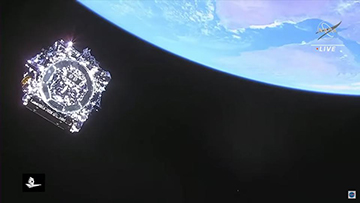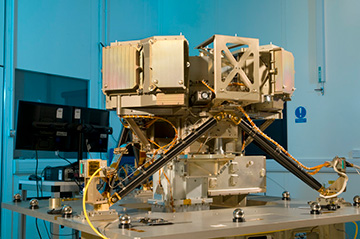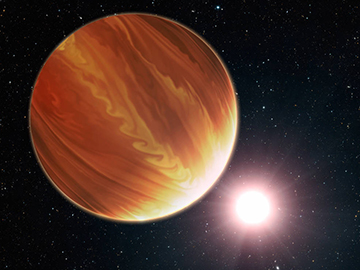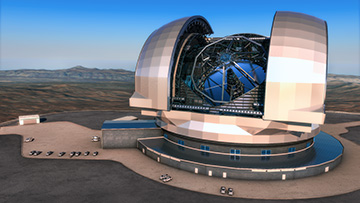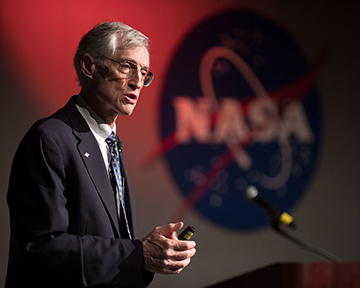
John C. Mather. [Image: NASA]
Between 25 December 2021 and 08 January 2022, scientists, engineers, space enthusiasts and members of the general public watched, enthralled, as the James Webb Space Telescope—the product of decades of work by thousands of people—was lofted into space and gradually unfolded itself to full deployment. Engineering milestones in the intricate journey thus far have included a flawless launch; the unfurling and tensioning of the spacecraft’s gossamer sunshield; the hinging into place of its 6.5-m, segmented, gold-covered primary mirror, and much more.
While Webb is now fully deployed, months of work remain—including insertion into its final orbit at the L2 Lagrange point, 1.5 million km from Earth, and the cooling and calibration of its sensitive near- and mid-infrared optical instruments—before the observatory can start taking the measure of the cosmos. To look at what’s ahead, OPN recently had the opportunity to talk with the Webb mission’s senior project scientist at NASA, the Nobel Prize winner (and Optica Honorary Member) John C. Mather.
Before we dive into the science and what’s ahead for Webb, I can’t resist asking about how the past few weeks have been for you. You’ve been involved with the Webb telescope for a long time—what was the biggest or most exciting moment in the deployment for you personally?
John Mather: I guess the point where I thought, “We’re going to do well,” was when we watched the almost immediate unfolding of the solar panels [when the spacecraft detached from the rocket]. It went exactly as planned, and it was quickly enough that they could catch it on the camera from the rocket. So I thought, “Okay, that’s a good sign!” We basically got a perfect launch and the exact trajectory we wanted, and that maximizes the lifetime of the fuel that we carry on board. We’re really thrilled with that.
As the Webb spacecraft drifted away from its launch vehicle after separation, a camera on the rocket captured this iconic image, shortly before the unfurling of the spacecraft’s solar-panel array. [Image: NASA] [Enlarge image]
To tell the truth, though, my attitude was always, “Of course this is going to work; we’ve done everything we should do.” I wasn’t really chewing my fingers as other people said I should. I thought, We have done the job we should do; our project management has always done the things that would protect the observatory, making sure that it would work. I don’t think they cut corners.
Of course, not cutting corners costs a lot of money. But when you’re dealing with something this big, there’s no choice—if you cut corners, it will not work. There’s this phrase from the Apollo days: “Failure is not an option.” And my thought is, Well, if you do not test it, failure is guaranteed.
So much of the media narrative around Webb, in the months and years ahead of the launch, was about those delays and cost increases. The perfect launch and deployment must have been a real vindication of the long process—of taking the needed time.
Yes, that’s how I thought about it, too. It was all thanks to many, many, many people, at many levels—from the technicians who persevered through COVID, all the way to people at congressional level, who said, “We still trust you; we’re still going to keep sending the money.” All of those people made a big difference. And if any of those levels had not worked, we wouldn’t be here.
Things have gone so well that we are even hearing some people saying it must not really have been as hard as everybody was claiming.
They have no idea … just no idea! I work closely enough with the project management to see some of what they do. And it’s awesome. What they do is far beyond the skill of an ordinary scientist. I’m a conceptual guy; I think about photons and mirrors and lenses stuff like that. They think about how to make something happen, and that’s an altogether different skill. They have to know about the photons, but they have a lot of other things to do, too.
Well, let’s talk a little bit about those photons, and about what’s coming. The observatory is fully deployed, but there’s a lot of adjustment and commissioning that still has to happen, both en route and when it’s arrived at its orbit 1.5 million km from Earth. What are some of the things we should be looking for as the instrument gets ready to make observations?
The big events are, I guess, first that the telescope and the instruments have to get cold enough to start getting pictures—to gather the photons that get turned into electrons. And then we can start thinking about focusing the telescope.
In the coming weeks, each of the 18 segments of the Webb Space Telescope’s massive primary mirror will be individually focused, and then tweaked until they behave as a single, 6.5-m mirror—in a process Mather calls “wonderfully complex.” [Image: NASA/Chris Gunn] [Enlarge image]
As you know, the primary mirror consists of 18 separate hexagons, and those, plus the secondary mirror, all have to be adjusted. They all have little motors on them. And it’s a wonderfully complex process—it takes 10 different algorithms, running in sequence, to get that to happen. Before we do any of that, of course, we first have to verify that they all move, and that we know how to measure their positions and all that.
After we’ve done all of the intermediate steps of focusing the individual segments, there’s the final focusing, where we have to make all 18 hexagons work as a single mirror. That’s done with a least-squares fitting process. Basically, we put a weak lens in front of the camera, and make sure that the image [of each mirror segment] is out of focus by a known amount … And then we feed the images into a least-squares fitting program here on the ground, and we solve for all of the mirror errors. This is an algorithm that was actually perfected when the Hubble [Space Telescope] was out of focus. And it’s a long and elaborate process.
This is what we do first. Then, after a while, when all of the instruments are cold enough, we check it again with a wider field of view.
What about the individual onboard optical instruments—I understand those need to be calibrated as well.
The first of the optical instruments that comes into focus and that can work is the near-infrared short-wavelength channel. But eventually, we have a cryocooler that runs the mid-infrared instrument down to 7K. And that takes a while. That’s a little bit … “interesting”; let’s put it that way. A lot of interesting things about controlling a remote cooler, with its compressors and its valves and all those things.
In a mission with this long of a timeline, you have to “freeze” the technologies at a relatively early point, so that you can actually get the job done. But technology keeps evolving after that. I’m curious whether any progress has been made since that technology freeze, in infrared detection in particular, that you wish were on the Webb.
The Webb’s Mid Infrared Instrument (MIRI) must be cryo-cooled to a temperature of 7 K to detect faint infrared signals from exoplanets and other targets. [Image: NASA] [Enlarge image]
Not very much, actually. The basic instrument technology had to be chosen when we started building them, and that was back in around 2002. We made our contractor selection, and we chose all the instrument teams at that point, including the international partnerships.
And the reason that nothing much has happened [since then] is that nobody else needs what we need. Very little progress is made in this area unless NASA pushes for it … there isn’t enough demand. No one else needs beryllium mirrors that we know of; no one else needs that particular kind of cooler to 7K.
Earlier you talked about the successful launch and the fuel savings that resulted. We are now hearing people talk about a much longer observing lifetime for Webb—as much as 20 years or possibly longer. Can you give me some sense of how that extra time might expand the scope of the questions that Webb can work on?
Usually, what happens with big projects like this is that the questions evolve with time as we learn things. When we start off with a plan—as we have for the first year of observations—we expect to say, “Well, that’s interesting; I didn’t know about that. We better pursue that some more.”
So that’s one. Another one that obviously takes a long time is the deep fields [sky surveys]. You know, the Hubble Deep Field took two weeks; we expect to spend weeks as well [with Webb]. And the various deep fields are not all the same. They’re different pieces of the universe. So you survey one piece of sky here, and ask if it’s statistically different from that piece over there—and it could be, because there’s what’s called cosmic variance. In this direction, there will be some clusters of galaxies, and in that direction, there won’t be. And you don’t know until you look.
Also, the longer you work, the more chance you have to find those very rare objects that you were hunting for. The first galaxies, the first supernovae, the first black holes—those are probably pretty hard to find. Not only are they faint, but they’re not very common. You have to take a lot of pictures before we find one. So [with a longer mission timeline], we have better odds of finding those most interesting first objects.
And some things just take a while to learn how to do them. To get at these very first objects, we need really long time exposures. But the question about those is always, Does the noise integrate down as the square root of time, or is something [else going on]? So before we invest all the time in taking a really long exposure, we want to know how to randomize that noise, so we get the full benefit of the long exposure.
The observations of exoplanets seem like another example.
In addition to observations of stellar nurseries and of the first stars and galaxies in the universe, Webb scientists hope to get a wealth of information on the atmospheres of distant extrasolar planets—but observing them with the new observatory, Mather notes, will have a definite learning curve. [Image: NASA, ESA, and G. Bacon (STScI)] [Enlarge image]
Yes; we have to really learn how to do exoplanets [with Webb]. We have two basic methods. One is to take a picture with a coronagraph, which blocks the starlight, and figuring out how to get rid of the glare of the star is the hard problem there … That’s a matter of skill and learning and knowing how our equipment works.
The other one, which is similarly difficult, is waiting for transits to occur. We know when a planet goes in front of its star that it will block some of the starlight, and we hope to get the spectrum of the blocked starlight and see if there’s an atmospheric signature. But this, again, is right at the edge of what’s technically possible. And if you have any weird behavior of the equipment, or of the target that’s getting in the way, then you may be fooled. You may think you’ve found something that’s not there, or you may miss something that’s actually there but you just didn’t have the confidence of your measurement. All of these things take time to work on.
So it sounds like, if the mission is extended, you’ll make good use of the extra years.
Oh, absolutely. We had well over a thousand proposals that came in for the first year. And we expect equally many for the second year.
If all goes well, the telescope is going to be pumping a lot of data back down to Earth for several decades. That seems like an interesting logistical and engineering challenge in itself. How is that being handled?
It’s actually pretty routine for that amount of data for NASA. We’re not sending much more data than Hubble. We do have to send it a little farther, but even that’s not a problem—the transmitters and antennas are plenty good enough for that … Although the amount of data you can get through the pipe is always an interesting challenge. So that is a resource to be managed.
One thing that we heard over and over in the press coverage of the deployment was people asking, “Why don’t you have cameras on this thing, so that we can actually watch the deployment in real time?”
We did, of course, think about that. But it’s harder than it sounds—because a lot of the interesting things you want to watch are in the dark and the cold. So now you want to string up wires all over this thing—and what are we going to learn?
We had to look at it very carefully. Of course, we would love to have pictures of it; everybody would love to have pictures of it. But we had to figure out a way to get by without them. And so far, so good.
Webb is probably taking up a lot of your scientific time. Are there other interesting problems you’re working on?
The European Extremely Large Telescope (EELT). In addition to his work on Webb, Mather is exploring the possible use of orbiting satellites to act as guidestars to enable extreme-performance adaptive optics for ground-based astronomy. [Image: ESO/L. Calçada] [Enlarge image]
One thing I’m currently thinking about is improved adaptive optics for ground-based telescopes. We’ve got a study we’ve been doing, and that seems to be catching on, about using an orbiting laser guidestar that can be placed in front of the target you want to see for long enough to support extreme-performance adaptive optics.
[The laser guidestars in today’s observatories work] by sending up laser light [from Earth’s surface] to make sodium atoms fluoresce in the middle atmosphere. But those aren’t real stars—you can’t really focus on them enough, and they’re not far enough away. Something that’s a lot more like a real star, in space, can solve your problem.
So this would be a spacecraft of known position and brightness, above the atmosphere, that could be used to calculate the wavefront shaping to cancel out the effects of the atmospheric turbulence?
Yes. And by orbit matching, we can actually stay in the right place long enough to be interesting. That’s my next big thing.
That would be exciting—as much as we’re focused on Webb, there’s so much coming up in the next generation of ground-based astronomy that’s going to be brilliant, too.
Yes, and with telescopes that are going to be absolutely enormous!
One other question, on kind of a different note. I’m wondering how you feel about the power of astronomy, and of something like the James Webb Space Telescope in particular, to inspire new generations of scientists, and public interest and enthusiasm for science?
Well, I’ve been excited about astronomy since I was little. It taps into the big questions: Where did we come from? How did we get here? What’s interesting, new and special about humans? And how far can we go?
That long story is really a basic story for an awful lot of people. And I think that’s what makes astronomy attractive—plus, we have beautiful pictures. So astronomy is a good way to draw people into science.
And then when they’re here, we’ve got a lot for them to do. Turn over all the rocks and see what’s under there. Let’s figure out how to manage our world … Young people are very interested in climate change. I went to the International Science and Engineering Festival a few years ago, and I would say that half of the exhibits that I saw, in the area of physics and engineering, were about better batteries and solar panels. So young people recognize that that’s where to go. And, of course, they’re having success.

